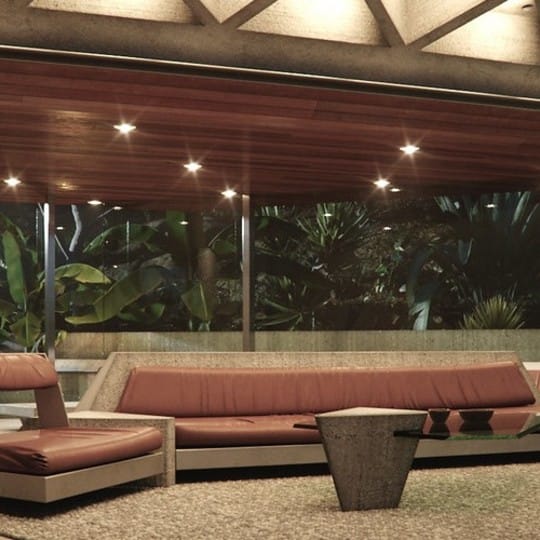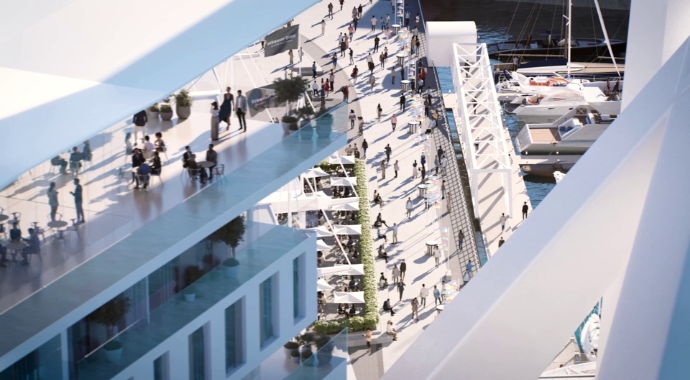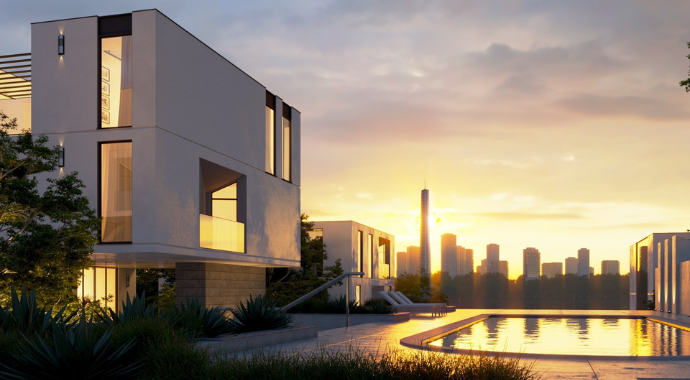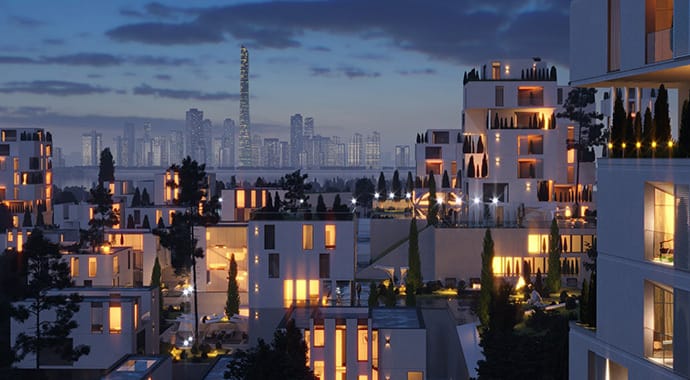Bertrand Benoit’s architectural renders of one of LA’s most iconic buildings, the Sheats-Goldstein Residence, were rendered with V-Ray GPU. Discover the workflow.
You’ve probably seen the Sheats-Goldstein Residence without realizing it. Completed in 1963, this feat of organic architecture has provided a dramatic backdrop for Charlie’s Angels: Full Throttle and Snoop Dogg music videos. Most notably of all, it also served as Jackie Treehorn’s pad in cult movie The Big Lebowski.
For Lebowski-fan Bertrand Benoit, the building, which features very few right angles as well as natural light delivered via drinking glasses (of course!) embedded in the ceiling, provided a perfect opportunity to put his lighting, modeling and materials skills to the test.
Here, he reveals how he made use of the GPU for architectural renders in V-Ray for 3ds Max — and gives a few tips on how to make the most of rendering on your graphics card.
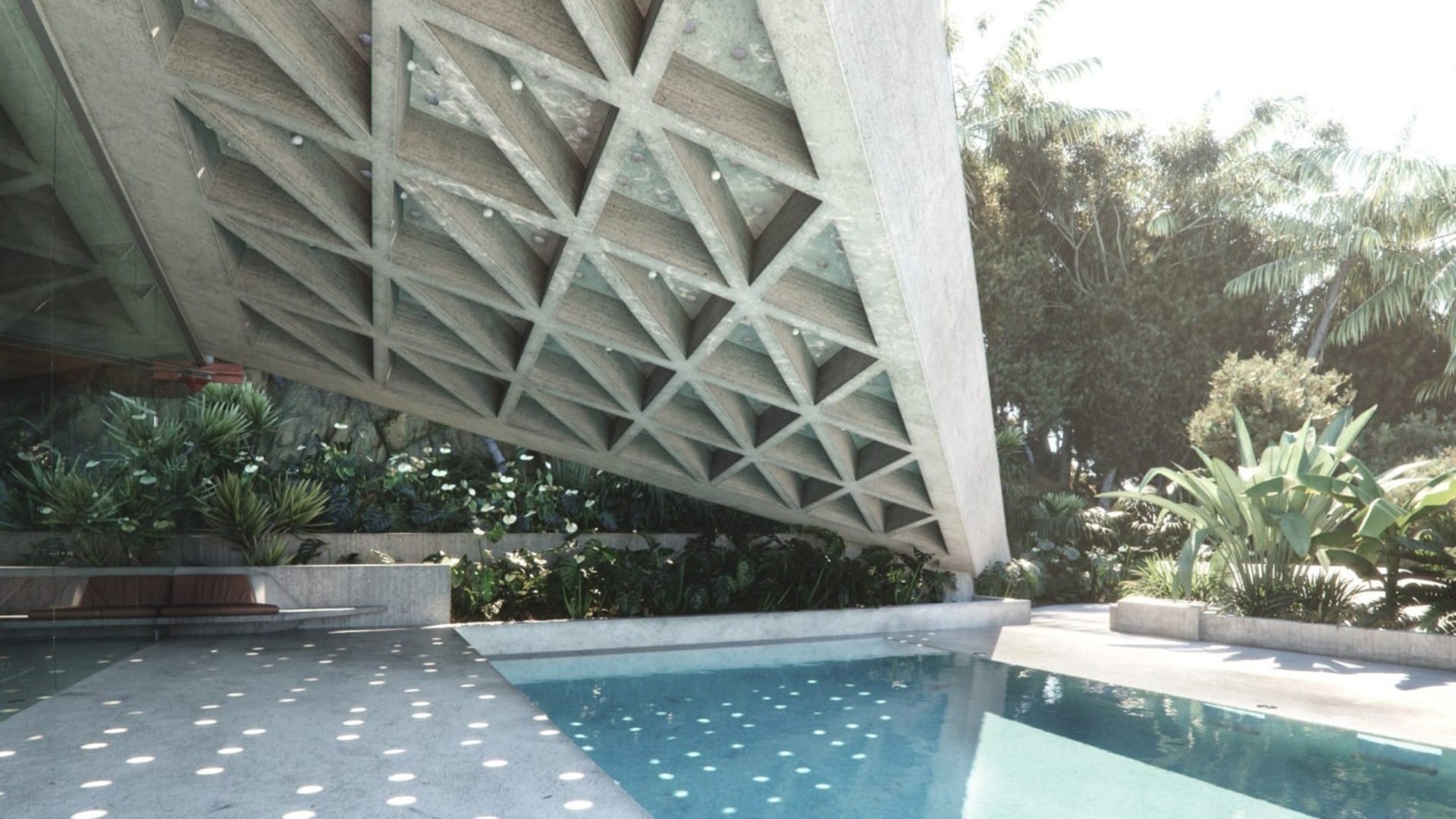
Could you tell us a little bit about yourself and BBB3viz?
Bertrand Benoit: If you want to go back all the way, I was born in France a very long time ago and somehow ended up in Berlin after a few twists and turns. I first became interested in CG in the late 2000s, starting with Blender, where I first used an early version of V-Ray for Blender, which then persuaded me to move to 3ds Max for the full V-Ray experience.
BBB3viz is the business I created to sell my 3D assets, but “business” is a big word for something that barely covers my license and hardware costs. The truth is that CG is and has always been a passion more than a profession. In the real world, I write for a living. My CG stuff is something I do for myself.
My mother is a professional artist and I was drawing with her as a child as far back as I can remember. She and I have always had this inescapable need to create visual stuff, whether it’s with physical media or photography or clay or whatever. CG, for me, is that outlet today and beyond my family, there is little that matters more to me.
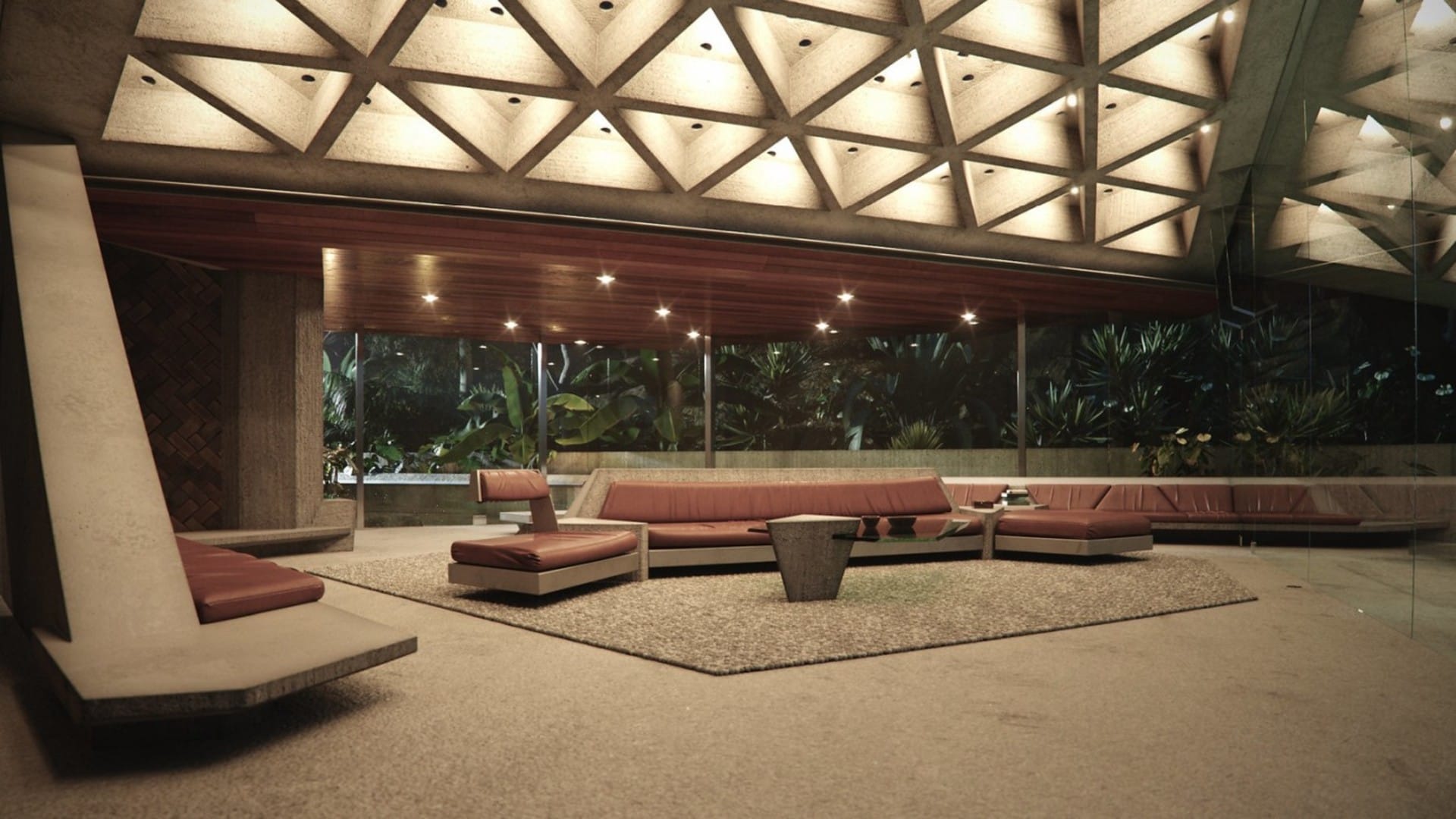
What inspired you to create this piece? How did you research it?
BB: One motif I’ve been returning to over and over again is the reproduction of existing architecture — landmarks, monuments, historically important buildings like the Bauhaus in Dessau or la Maison de Verre in Paris.
The Sheats-Goldstein Residence is one of those buildings that everybody knows without necessarily knowing what and where it is. Even if you’ve never watched The Big Lebowski, you will have seen it in music videos or magazines. It immediately evokes something. So the goal with these pieces is to make an image from scratch that is not the real thing but immediately evokes the feeling of the real thing when you see it. I would never compare myself to Ian Spriggs but I guess this is the same feeling that he’s trying to create: To make something completely artificial that triggers the same emotion that the real thing does.
Another reason for picking this house was the technical challenge. The building is complex in itself — no 90-degree angles here! — and fitting such a lush tropical environment onto the GPU was something I was curious to try and make work.
As for researching it, there aren’t that many blueprints around. But James Goldstein has such a prolific online presence and there is such love for the place that there is no shortage of photographic and even video reference, which I used both for modeling and as an inspiration for the shots. And there was a viewing of the Big Lebowski, of course.
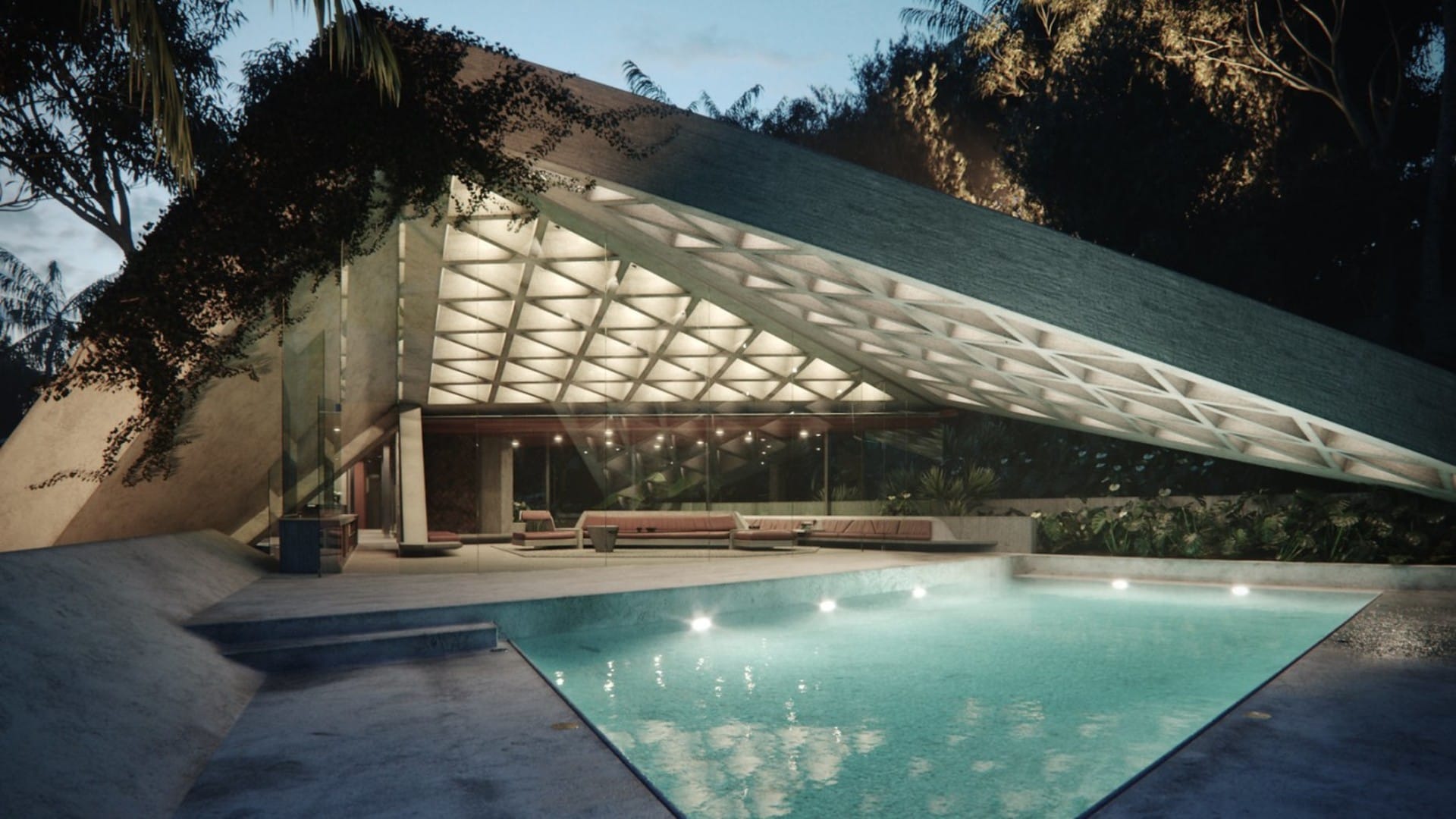
You’ve rendered both day and night versions — can you talk a little about the lighting setup of each one?
BB: The day shots are very simple. I used a simple sun and quite a bit of Environment Fog. There are also hidden emitters here and there to simulate caustics from the pool. Since the sun has a different position in every shot, I opted to have as many suns in the scene as there are cameras and would turn them on and off depending on the view I was rendering.
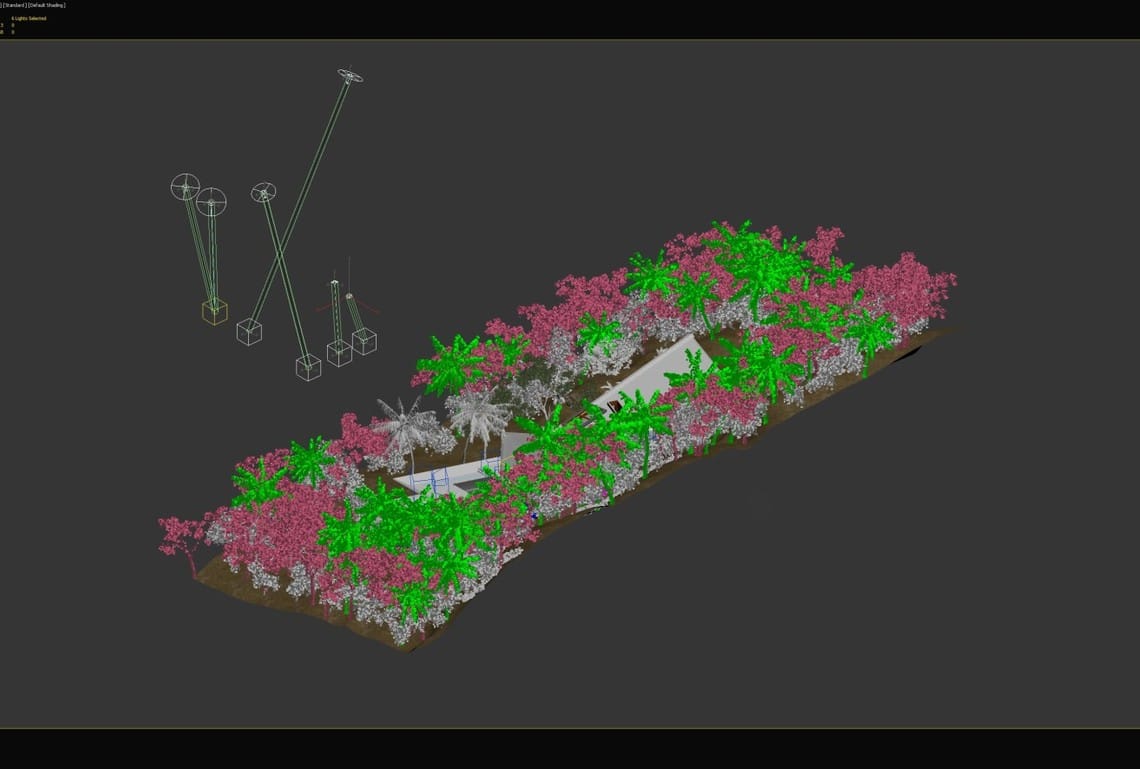
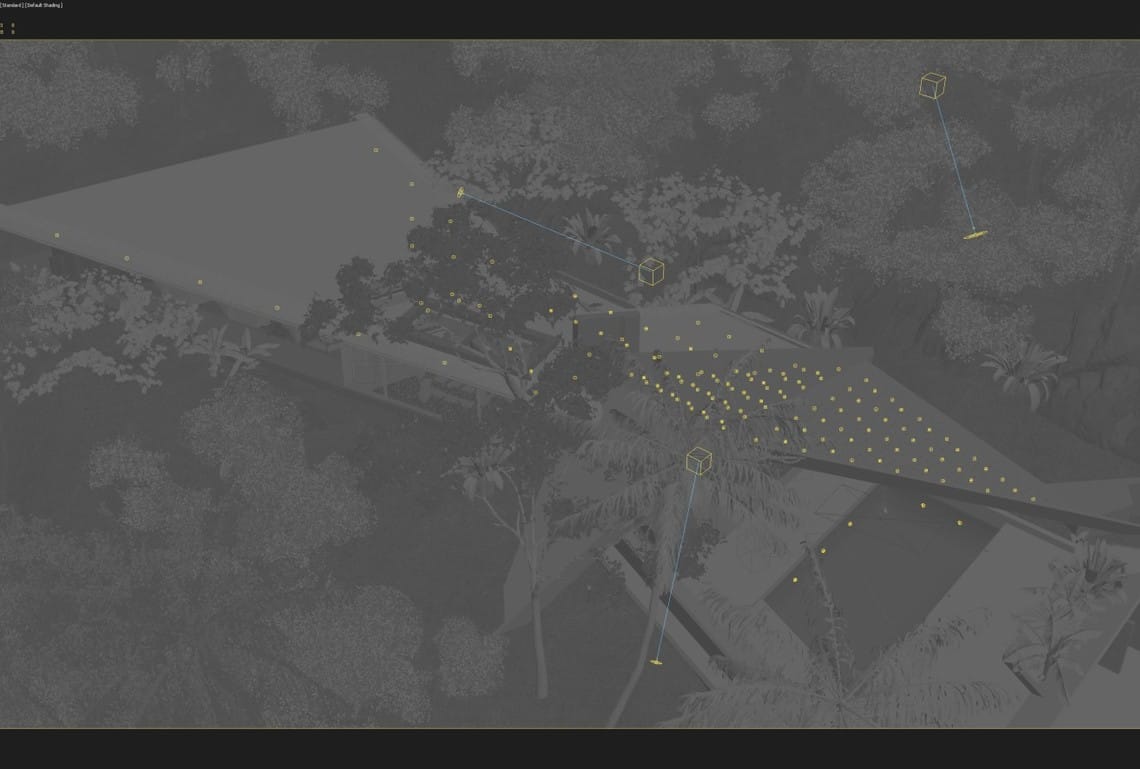
The night shots are more complex, with hundreds of lights nestled in every nook and cranny of the building, including in the pool, in the pond, on the roof and throughout the garden. The main challenge there was to balance the temperature and intensity of the various artificial lights with that of the Peter Guthrie twilight HDR. Peter Guthrie skies have the huge advantage of being perfectly color calibrated, so you can use them as a point of departure when tweaking other lights. That balance is a huge part of creating a realistic mood.
V-Ray has been and remains at the center of my CG universe … I love how deeply it is integrated in 3ds Max.
Bertrand Benoit, BBB3viz
You’ve been using V-Ray for a long time. What are the features in V-Ray Next that you now couldn’t imagine living without?
BB: I’ve used many renderers over the years but V-Ray has been and remains at the center of my CG universe. Frankly, it’s the main reason I’m still using 3ds Max. I love how deeply it is integrated in 3ds Max; I’ve developed an instinctive understanding of how it treats materials and it’s definitely the one I’m most at ease with.
I’m particularly enthusiastic about the GPU version — I haven’t used the CPU for a while now. I love how fast Environment Fog and volumes, in general, render on the GPU and I love how well V-Ray plays with other plugins that I use all the time, like iToo’s Forest Pack and RailClone.
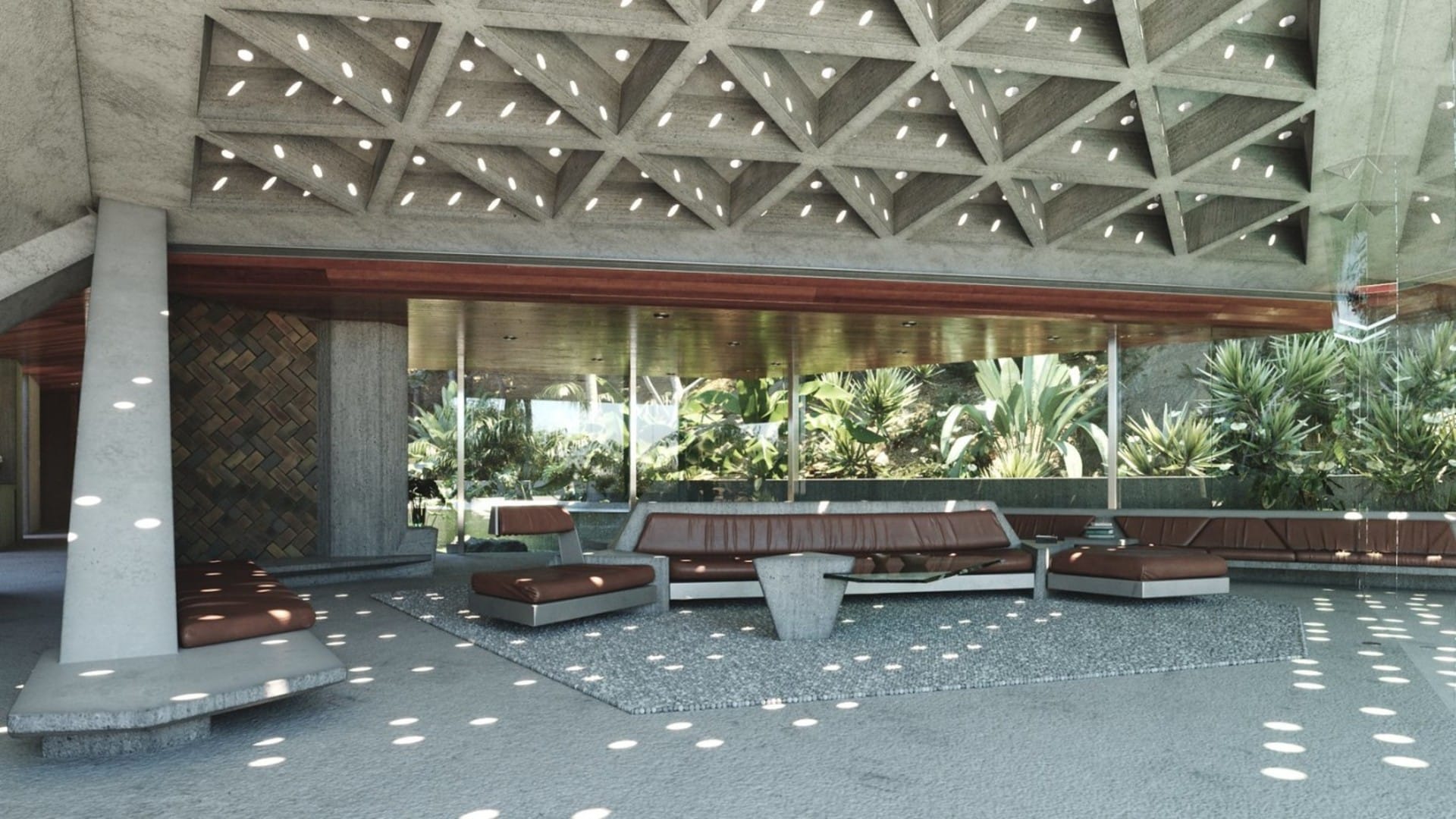
The Sheats-Goldstein Residence has drinking glasses embedded in the roof to provide natural light. Did you have to tweak the scene at all to include this interesting feature?
That’s right! I actually didn’t model the glasses since they wouldn’t have been visible from any of the angles I used, and they would have slowed the rendering considerably. I did have this dilemma when modeling the Maison de Verre, where the external walls are entirely made up of thick glass tiles with an air bubble inside. A ray-tracing killer! In the end, I had to make them visible to the camera but not to the lights. This was a while ago, though, and they may have rendered fine in a more recent version of V-Ray.
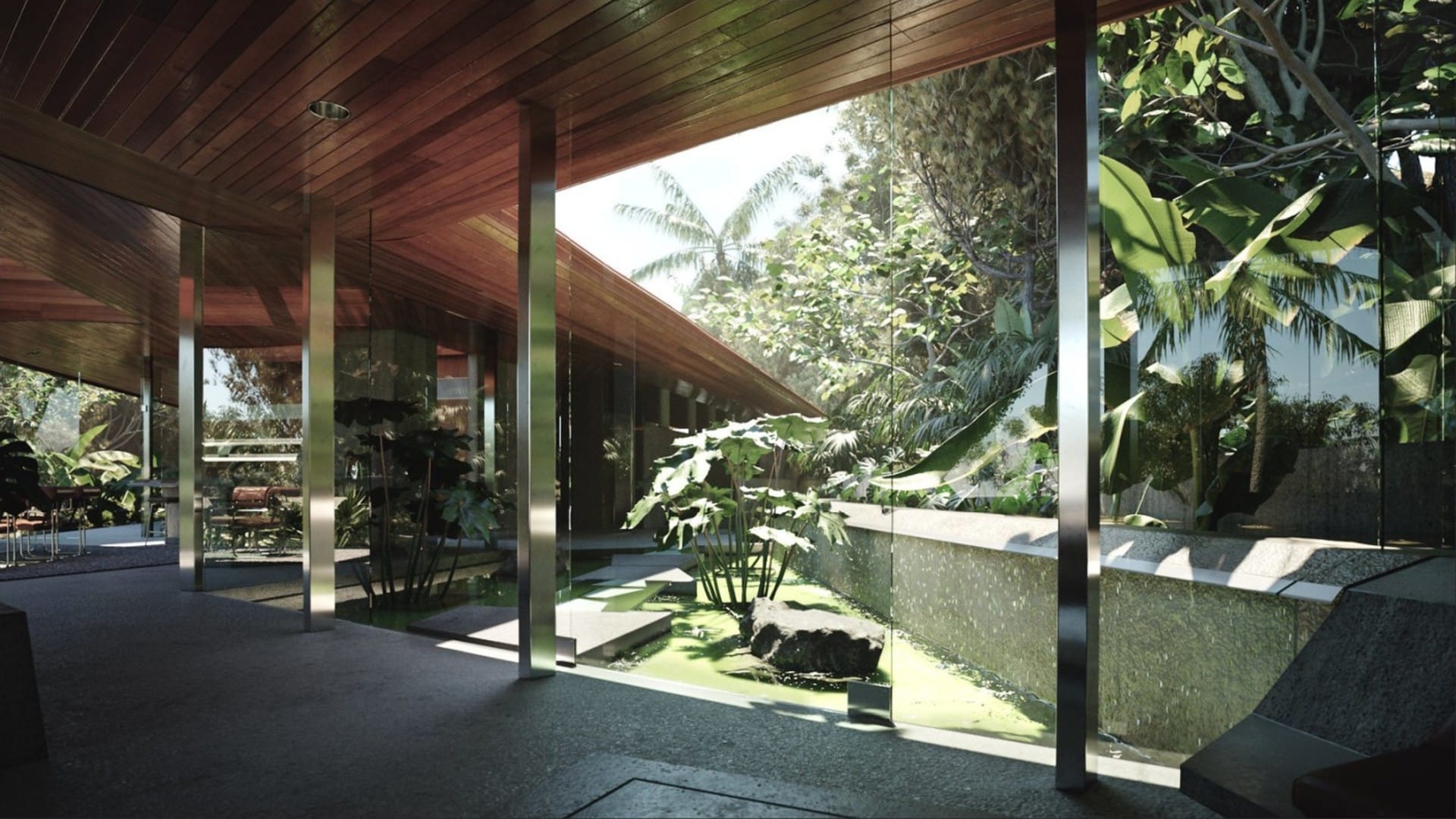
Could you tell us a bit about your camera setup? Do you tend to stick to the defaults?
BB: I do a fair bit of photography on the side and I approach my CG cameras the way I would my SLR. I try to use real-life values for aperture and exposure, I use the types of lenses that I own in real life and I try to pay attention to white balance and this kind of detail, without necessarily being too knowledgeable about it.
I would also say that my main inspiration has always been photography rather than other artworks. Photography is really the world in which my CG work lives and the photographic look is mostly what I aspire to.
Bertrand’s favorite photographers
Studying work by expert real-world photographers can help bring your CG scenes to life — but it can be hard to know where to begin. We asked Bertrand to list his biggest influences, in no particular order:
“And some famous digital artists, such as Ash Thorp or Peter Guthrie, are amazing photographers in their own right,” says Bertrand.
How much post-production do you do on your images?
BB: Actually less and less. Given how sophisticated the VFB has become over the years, there’s hardly anything that can’t be done in it; chromatic aberration would be the only thing really. So there is a little post-production but mostly in the VFB — the main one is a custom S-curve that varies a little bit from image to image. Beyond that, I might use a few LUTs from time to time, as well as built-in glow and glare.
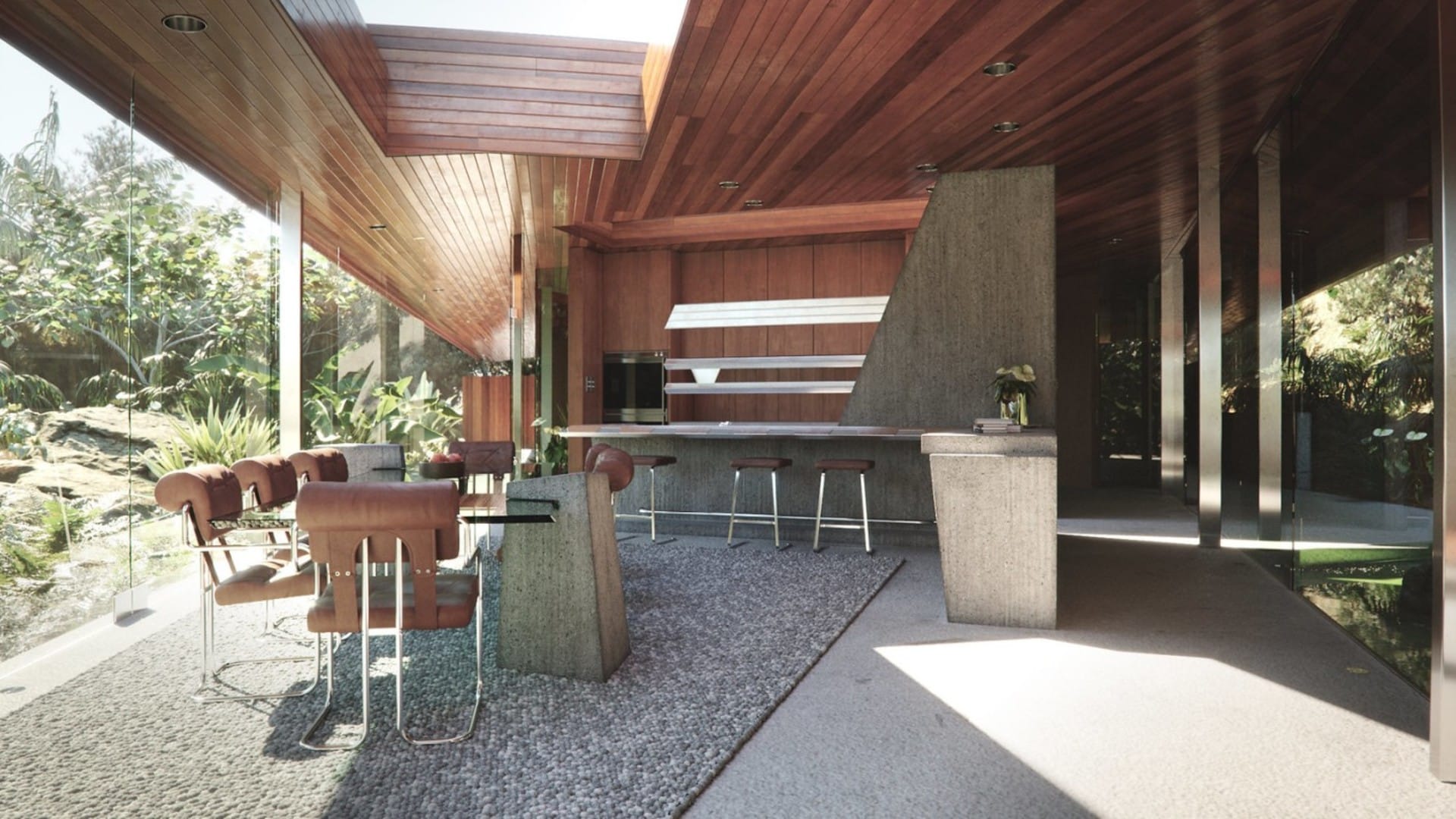
When and why did you switch to GPU?
BB: I switched completely when the Nvidia 1080ti card came out. As a hobbyist, I don’t have the best gear and so render times have always been the main factor holding me back. This is definitely the huge advantage of V-Ray GPU. Now, render time is no longer an issue.
There are a few minor sacrifices: V-Ray GPU doesn’t have full feature parity with the CPU version, and you have to be strategic in how you build your scenes given the VRAM restrictions. But, given the choice, I would take a faster render any day!
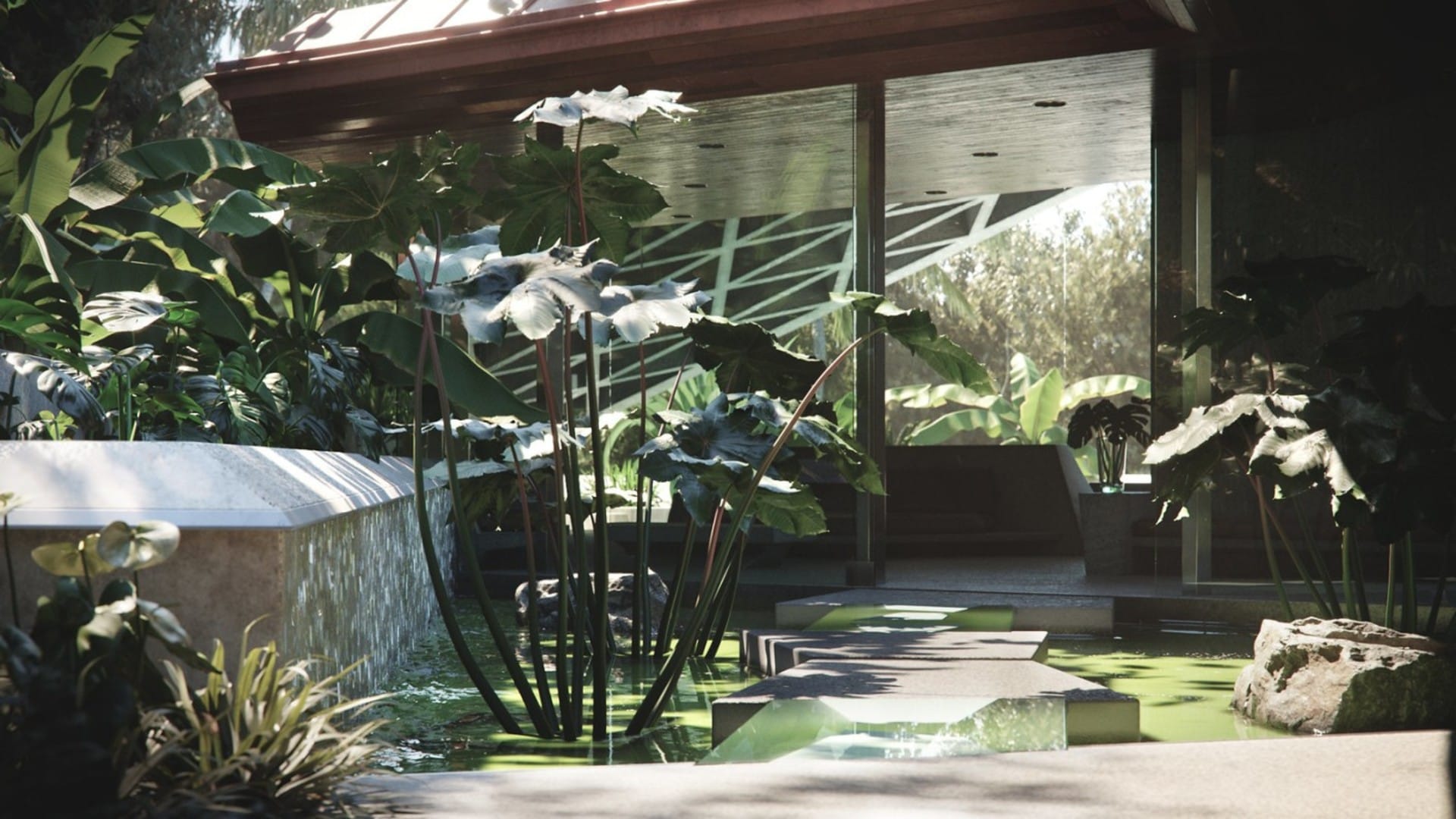
What hardware do you find best for V-Ray GPU?
BB: I’ve been upgrading regularly to the latest (consumer) cards. Right now, I use a pair of RTX 2080ti with an NVlink bridge. My rig is air-cooled though, so things get pretty hot and noisy.
Bertrand’s top 7 V-Ray GPU rendering tips
“As the software and the hardware evolve, there are fewer and fewer restrictions on GPU rendering,” says Bertrand. “On-demand mip-mapping and out-of-core rendering will mean less optimizing necessary in the future. This means fewer and fewer GPU-specific tips and tricks too.”
- Be organized when building your scenes — this will save you time when it comes to optimizing.
- Use V-Ray instances whenever possible — instead of duplicating geometry to save on VRAM.
- Do the same with materials — I have a few grunge maps in my material editor that I tend to reuse over and over again in different materials in the same scene, either as glossiness maps or even as diffuse maps combined with V-Ray Color maps. I also use a fair amount of procedurals and textures such as V-Ray Dirt or V-Ray Distance that help hide repetitions when using tileable maps.
- Shade in the viewport — why bother with small material preview balls when you can iterate in real-time?
- Put your budget in the GPU — and (if you can afford it) stay up-to-date. I tend to use my cards for a year and sell them when the latest models come out.
- Use displacement sparingly — I’ve found it to be very VRAM hungry.
- Make use of tricks from the worlds of games and real-time — you don’t always need a full-res scan of a rock; a mid-res scan with a great normal map often reads just as crisp for a smaller VRAM footprint.
How have Lebowski fans responded to this piece? What has been your favorite response so far?
BB: It was a lot of fun to get feedback from a number of people who aren’t necessarily CG fans or arch-viz connoisseurs — the arch-viz world is pretty small. I was especially happy to hear from one or two people who had visited the place, and even one person from team James Goldstein wrote back! And I got a huge collection of fun Lebowski quotes and memes. It even got a mention on my favorite podcast: Martini Giant.
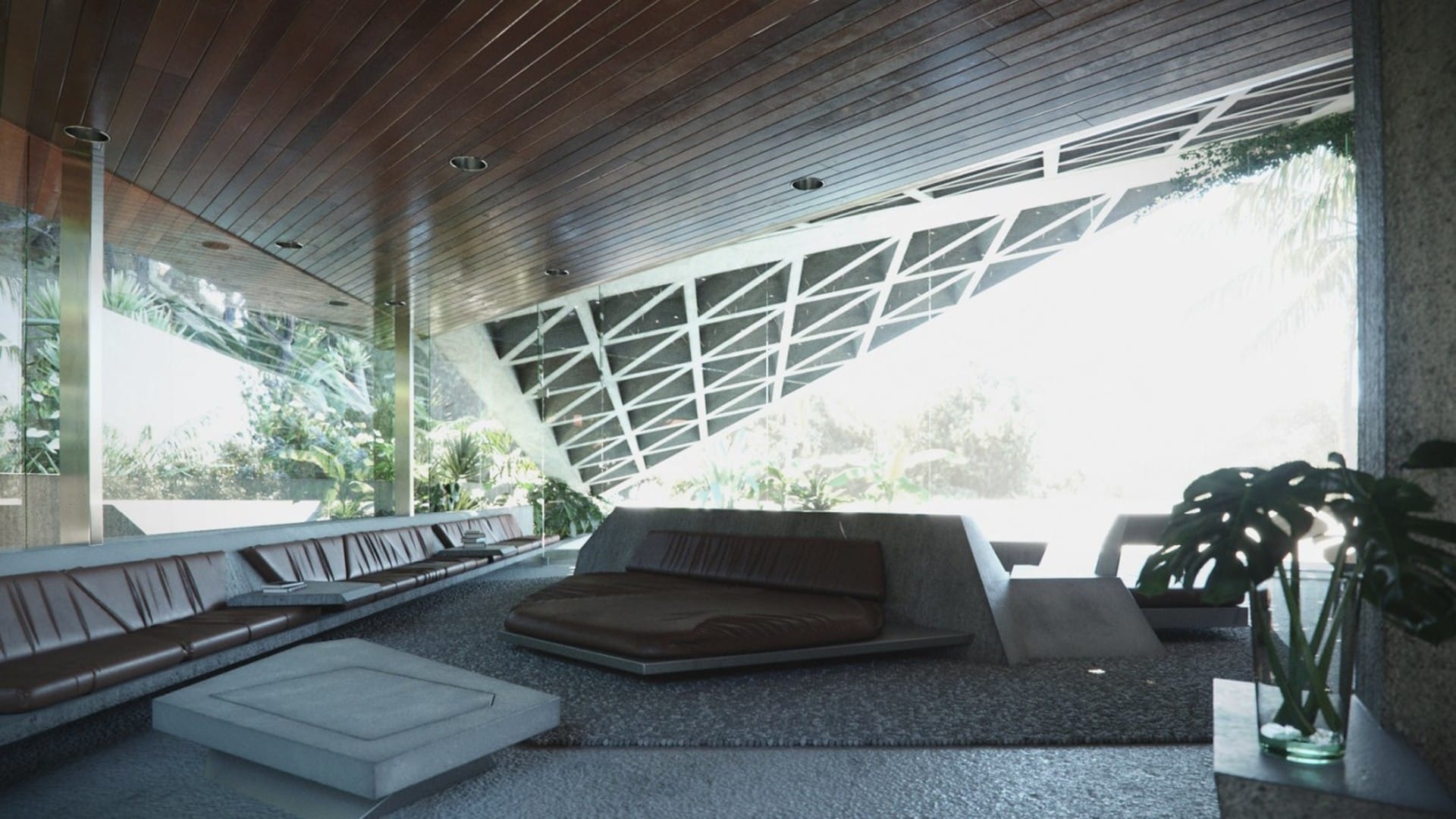
What are you working on next?
BB: I’ve got it into my head to model an entire block of the Soho neighborhood in Manhattan. I’m in New York quite often for work, and in recent years I’ve been staying between Washington Square and Canal Street. I love cast-iron architecture and the mood it creates. It’s very elegant, immediately recognizable and, at the same time, the repetition of the cast architectural elements give it a very industrial feel. The challenge here will be to make it fit all in the VRAM. There is a lot of detail in one Manhattan block!
California dreamin’? Empire State of mind?
Shed the best possible light on your architectural designs with a free 30-day trial of V-Ray Next for 3ds Max, and explore them in real-time using the Project Lavina beta.



